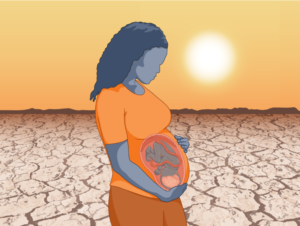 A new study has revealed that climate disasters like Superstorm Sandy may be quietly shaping the brains of babies even before they are born. Scientists at The City University of New York (CUNY) Graduate Center and Queens College have found that children whose mothers were pregnant during the devastating 2012 storm show distinct differences in brain development, which could impact their emotions for years to come.
A new study has revealed that climate disasters like Superstorm Sandy may be quietly shaping the brains of babies even before they are born. Scientists at The City University of New York (CUNY) Graduate Center and Queens College have found that children whose mothers were pregnant during the devastating 2012 storm show distinct differences in brain development, which could impact their emotions for years to come.
The research, published in PLOS One, suggests that climate events especially when combined with extreme heat can alter the growth of critical brain areas that control how emotions are processed.
“We are seeing how climate change might already be affecting the next generation before they even take their first breath,” said Donato DeIngeniis, the study’s lead author and a psychology Ph.D. student at CUNY. “Their brains carry invisible marks from disasters they never directly experienced.”
Storm Stress and Heat Impact Brain Development
The scientists used brain scans to study a group of 8-year-old children whose mothers were pregnant during Superstorm Sandy. The results were surprising: the children who had been exposed to the storm in the womb had larger basal ganglia, a part of the brain that helps regulate emotions and behavior.
“The mix of storm stress and extreme heat created the perfect storm for the developing brain,” explained Professor Yoko Nomura, lead investigator of the Stress in Pregnancy (SIP) Study. While heat alone did not show major effects on the brain, its combination with the stress of living through a natural disaster during pregnancy made a big difference.
The research team compared MRI scans of 34 children, some of whom had been exposed to either the storm, extreme heat (with at least one day over 95°F during pregnancy), or both and some who had not experienced these conditions at all. Those who had faced both heat and storm stress showed the most noticeable brain differences.
A Warning for the Future Generation
These findings are concerning, especially as climate change causes more frequent and severe storms, floods, and heatwaves across the globe.
“As extreme weather becomes more common, we have to think about what it could mean for the health of future generations,” DeIngeniis said. “Our study suggests that supporting pregnant women during disasters is urgent not just for their own wellbeing, but also for the lifelong health of their children.”
Dr. Duke Shereen, director of MRI research at CUNY and co-author of the study, warned that these brain changes could lead to long-lasting emotional or behavioral challenges. “We’re seeing clear evidence that environmental stress can be passed from mother to baby during pregnancy, reshaping the brain’s architecture,” he said. “The climate crisis is not only about melting ice or rising seas it could also be a growing public health and mental health emergency.”
More Research Needed
While the study focused on a small group of children, the results raise big questions about how climate-related disasters could silently affect the mental and emotional development of babies around the world.
Experts say more research is needed but these early findings send a strong message: climate resilience and disaster preparedness must also protect the most vulnerable expectant mothers and their unborn children.
